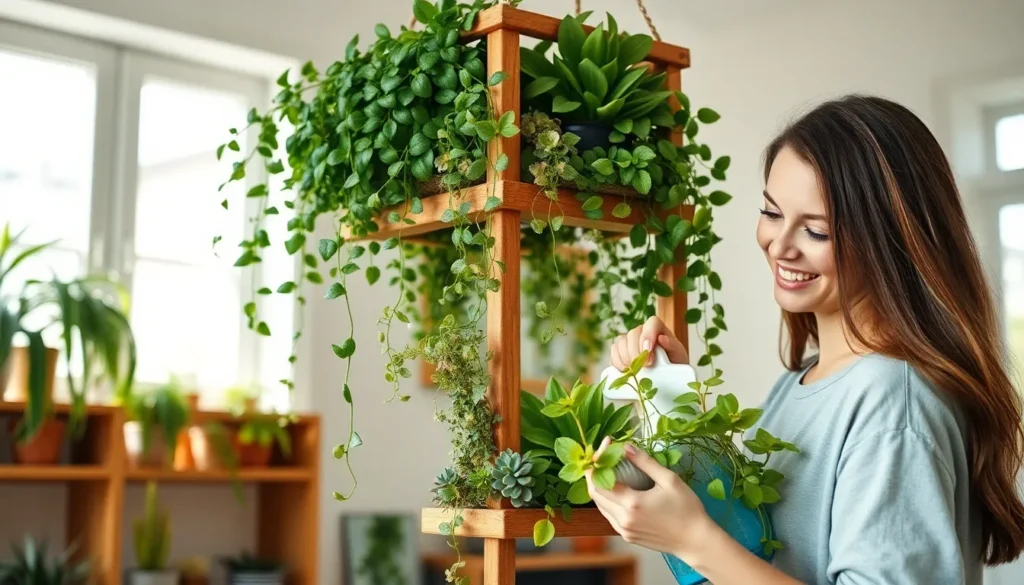We’ve all struggled with limited floor space when trying to create our dream indoor garden. That’s where hanging ladder plant displays come to the rescue – transforming vertical space into a stunning botanical showcase that maximizes every inch of your home.
These innovative plant ladders aren’t just space-savers; they’re conversation starters that add rustic charm and natural beauty to any room. Whether you’re working with a tiny apartment or simply want to create an eye-catching focal point we’ll show you how hanging ladders can revolutionize your plant game.
The best part? You don’t need to be a DIY expert or spend a fortune to achieve this look. With the right techniques and plant selections hanging ladder displays offer an affordable way to bring nature indoors while solving your space constraints. Let’s explore how you can create your own vertical garden paradise.
What Is a Hanging Ladder With Plants and Why Should You Consider One
A hanging ladder with plants transforms a simple wooden or metal ladder into a stunning vertical garden display by suspending it from the ceiling or mounting it against a wall. This innovative approach lets you showcase multiple plants at different heights while creating an eye-catching focal point that draws attention upward.
Space efficiency makes hanging ladder displays particularly appealing for small homes and apartments. We can use unused vertical space to grow herbs, succulents, trailing vines, and flowering plants without sacrificing precious floor area. The ladder structure provides multiple tiers for different plant varieties, effectively multiplying your growing capacity in a compact footprint.
Visual impact comes naturally with this design approach since the ladder creates clean lines and geometric interest that complements modern and rustic decor styles alike. Plants at varying heights add depth and dimension to rooms that might otherwise feel flat or cramped. The suspended arrangement allows light to filter through each level, creating beautiful shadows and highlighting the natural beauty of your plant collection.
Maintenance advantages become apparent when you consider how easy it is to water, prune, and care for plants arranged on a ladder system. Each plant remains easily accessible without the need to move other containers or navigate around furniture. We can quickly identify plants that need attention and address issues before they spread to neighboring specimens.
Cost effectiveness makes this option attractive compared to purchasing multiple individual plant stands or expensive wall-mounted systems. A basic ladder costs significantly less than specialized plant furniture, and you can customize it with paint, stain, or decorative elements to match your existing decor. The versatility means you can rearrange plants seasonally or add new varieties without investing in additional equipment.
Creative flexibility allows you to experiment with different plant combinations, pot sizes, and hanging methods to achieve your desired look. We can incorporate trailing plants that cascade between rungs, compact specimens that fit neatly on each step, or larger statement plants that anchor the display. This adaptability means your hanging ladder garden can evolve with your skills and preferences over time.
Choose the Right Ladder Material for Your Plant Display
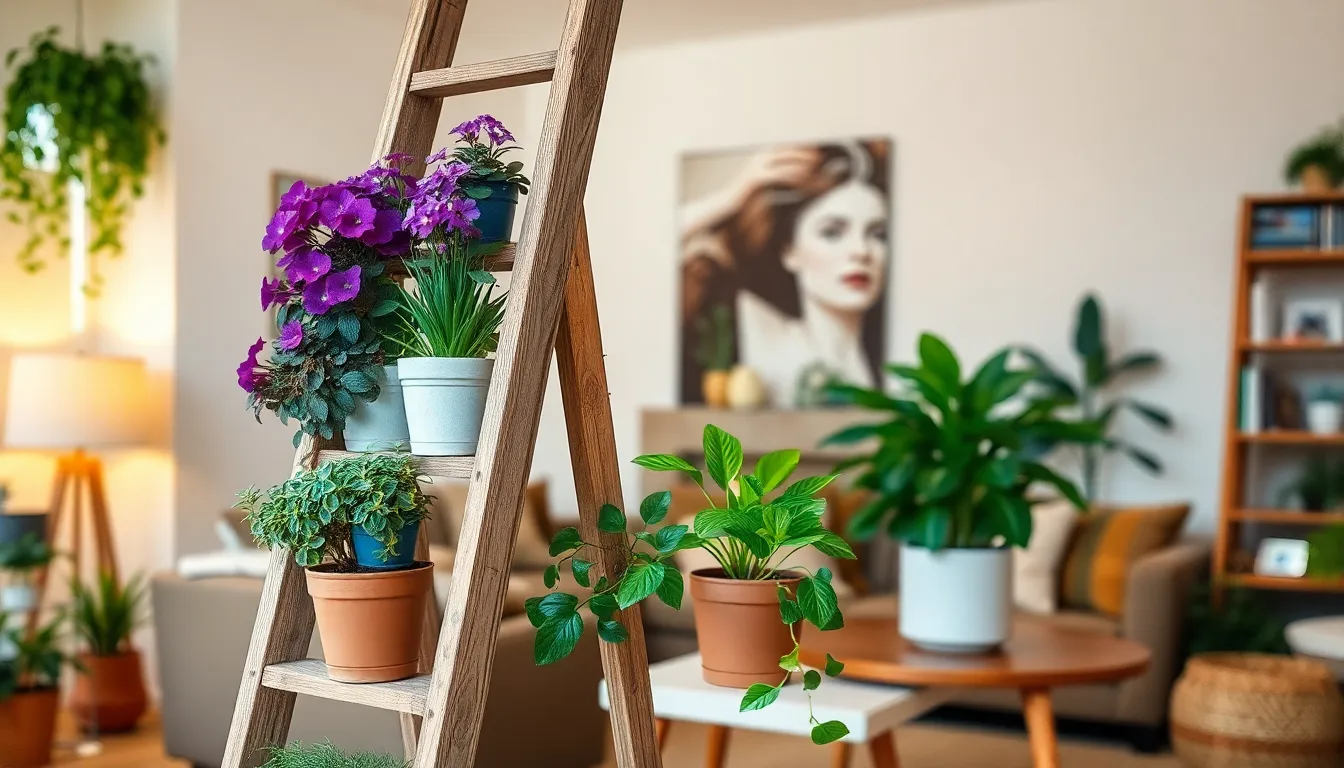
We’ve found that selecting the right ladder material dramatically impacts both the aesthetic appeal and longevity of your hanging plant display. Different materials offer unique benefits that can perfectly complement your existing decor style.
Wooden Ladders for Rustic Charm
Wooden plant ladders create the most popular choice for homeowners seeking that warm, natural texture and color. These ladders suit a variety of home decor styles, especially rustic or farmhouse themes that emphasize organic materials. Creating your own wooden ladder becomes a rewarding DIY project using basic wood screws, glue, and sanding techniques for a completely customized finish.
Maintaining wooden ladders requires regular oiling to prevent cracking or drying out over time. They provide an exceptionally sturdy base for various plant types, from trailing pothos to heavier succulents. Styling wooden ladders allows you to achieve that natural and inviting look that makes any space feel more welcoming and organic.
Metal Ladders for Modern Appeal
Metal ladders crafted from steel or aluminum deliver a sleek and contemporary aesthetic that transforms any room. These structures offer superior strength and stability while remaining lightweight enough for easy repositioning. Different finishes including painted, powder coated, or brushed options help you complement modern and industrial decor themes.
Users who prefer minimalistic garden displays find metal ladders perfectly suited to their design vision. Cleaning these ladders requires only mild soap and a soft cloth to maintain their pristine appearance. Their durability makes them ideal for supporting heavier planters without compromising structural integrity.
Bamboo Ladders for Eco-Friendly Options
Bamboo ladders represent the most sustainable and environmentally conscious choice for plant displays. This material combines lightweight construction with impressive strength, while its natural golden color adds fresh, organic vibes to any space. Tiered bamboo designs help maximize vertical growing space while maintaining an elegant, minimalist profile.
Garden patios and eco conscious living spaces benefit tremendously from bamboo’s renewable properties. These ladders highlight your commitment to sustainable living while providing practical plant storage answers. Their natural resistance to moisture makes them particularly suitable for humid environments where plants thrive.
Select the Perfect Plants for Your Hanging Ladder Display
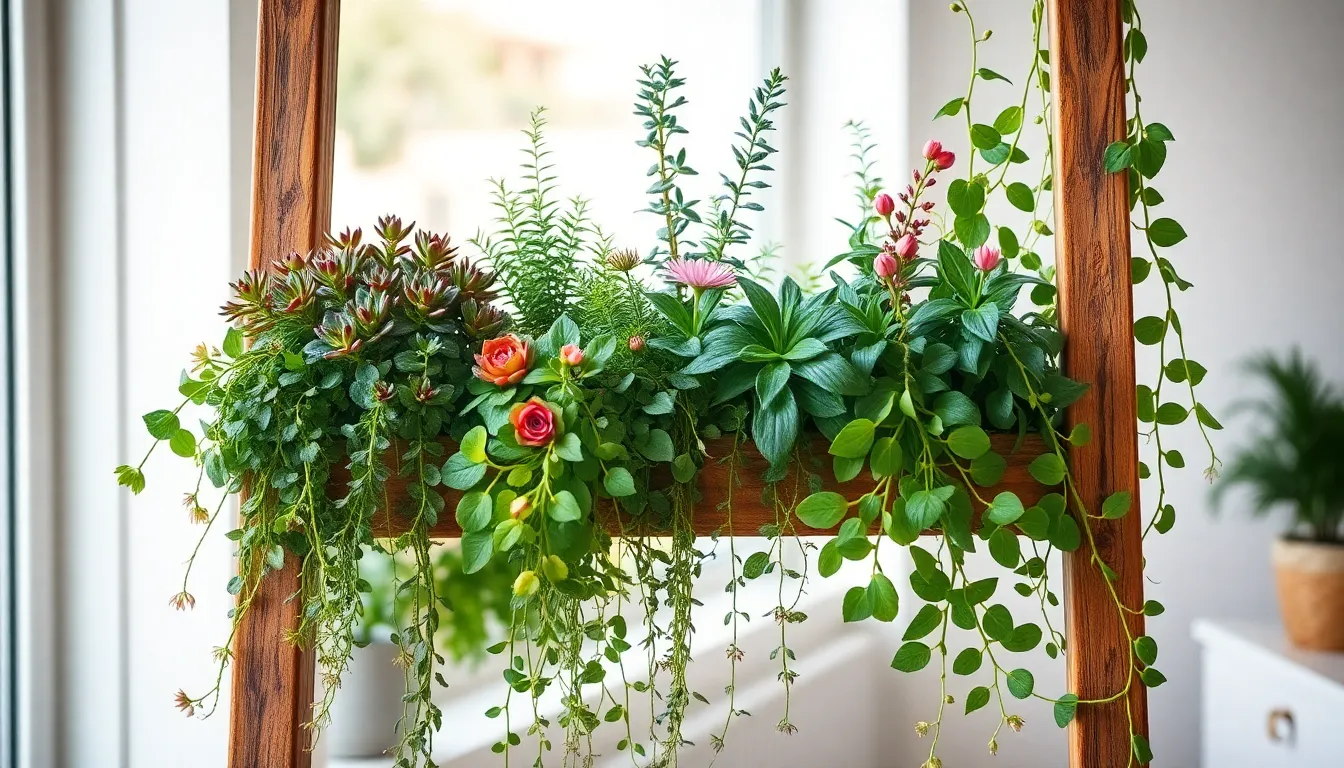
Choosing the right plants transforms your hanging ladder from a simple structure into a thriving vertical garden that complements your space perfectly.
Low-Maintenance Succulents and Air Plants
Succulents like Echeveria and Haworthia create stunning focal points on ladder rungs while requiring minimal care from busy plant enthusiasts. These sculptural beauties thrive in well-lit areas and store water in their leaves, meaning you’ll only need to water them occasionally. Air plants (Tillandsia) offer even more flexibility since they don’t require soil at all, allowing you to place them creatively on any ladder rung or suspend them in decorative holders.
We love how these low-maintenance options work perfectly for beginners or anyone with a hectic schedule. Their compact growth habits ensure they won’t outgrow their designated spaces quickly, while their varied textures and forms add visual interest without overwhelming your display. Both plant types prefer bright, indirect light and can tolerate some neglect, making them ideal candidates for your hanging ladder garden.
Trailing Vines for Cascading Effects
Trailing vines bring dramatic visual impact to your hanging ladder display by creating elegant cascading effects that soften the structure’s geometric lines. Pothos varieties offer heart-shaped leaves and vigorous growth, while String of Pearls provides unique bead-like foliage that creates eye-catching draping patterns. English Ivy adds classic beauty with its traditional vine appearance and ability to create lush green waterfalls from upper ladder rungs.
Position these trailing beauties on higher steps to maximize their cascading potential and create depth in your vertical garden. Most trailing vines prefer indirect light and moderate watering, making them relatively easy to maintain while delivering maximum visual impact. We recommend mixing different vine types to create varied textures and growth patterns that keep your display interesting throughout the seasons.
Herbs for Functional Beauty
Herbs transform your hanging ladder into a practical kitchen garden that provides fresh ingredients while adding natural fragrance to your space. Basil, mint, rosemary, and thyme thrive in hanging ladder displays when positioned near sunny windows or well-lit areas. These aromatic plants offer the dual benefit of culinary utility and decorative appeal, making your vertical garden both beautiful and functional.
We suggest placing herb containers on easily accessible rungs so you can harvest fresh leaves for cooking without difficulty. Most herbs require regular watering and good sunlight exposure, so position them accordingly on your ladder display. Their varied leaf shapes and growth habits create textural interest while filling your home with delightful natural scents that enhance the overall sensory experience of your plant display.
Find the Ideal Location for Your Hanging Ladder With Plants
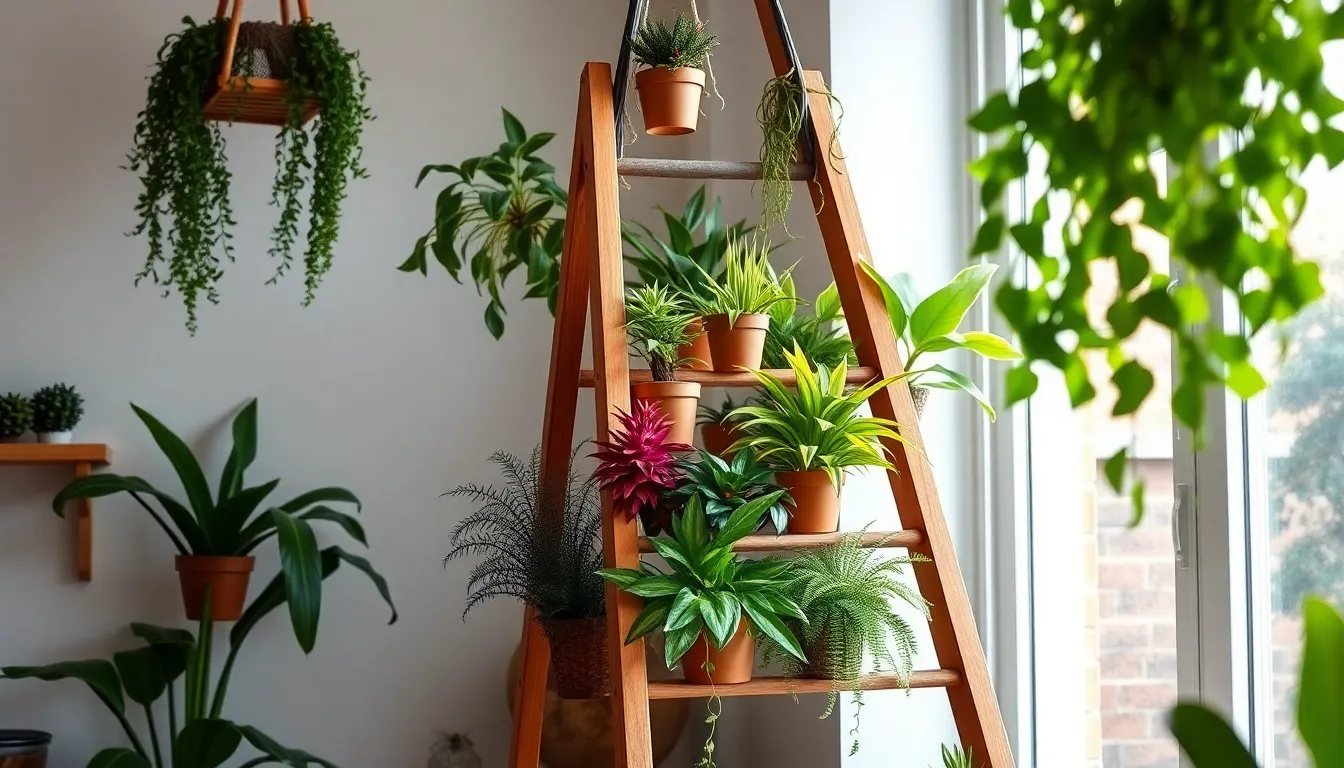
Location determines the success of your hanging ladder plant display more than any other factor. We’ll explore both indoor and outdoor placement strategies to help you create the perfect growing environment.
Indoor Placement Considerations
Lighting requirements should guide your placement decisions first. Most plants thrive near windows where they receive adequate natural light throughout the day. We recommend positioning your ladder in bright corners or entryways that get consistent indirect sunlight, as harsh direct rays can damage delicate foliage.
Space efficiency makes hanging ladders perfect for smaller rooms. Bedrooms, home offices, and narrow hallways benefit from vertical plant displays that don’t consume valuable floor space. Your ladder transforms these areas into living spaces without creating clutter or blocking walkways.
Safety considerations require secure installation methods. We suggest using sturdy ceiling hooks rated for the weight of your ladder plus plants and water. Wall-mounted brackets work well for leaning ladders, but they must be anchored into wall studs to prevent accidents.
Style coordination enhances your room’s existing décor. Modern spaces pair beautifully with sleek metal ladders and geometric planters, while rustic rooms complement wooden ladders with natural fiber containers. Scandinavian interiors work well with light wood ladders and minimalist white pots.
Outdoor Hanging Options
Weather resistance becomes crucial for outdoor installations. We recommend using treated wood or powder-coated metal ladders that withstand rain, humidity, and temperature fluctuations. Antique ladders need proper weatherproofing with marine-grade sealers before outdoor use.
Sun exposure patterns affect plant health significantly. Morning sun locations work best for most plants, providing gentle light without the harsh intensity of midday rays. We suggest observing your space throughout the day to identify areas with appropriate light levels for your chosen plants.
Drainage systems prevent water damage and root rot. Outdoor hanging ladders need planters with adequate drainage holes and saucers to catch excess water. We recommend elevating the ladder slightly to allow proper airflow underneath.
Vertical gardening maximizes small outdoor spaces efficiently. Patios, balconies, and compact yards benefit from ladder displays that create garden impact in minimal square footage. Your hanging ladder allows you to grow vegetables, herbs, and flowers in a creative vertical arrangement.
Secure Your Hanging Ladder Properly for Safety
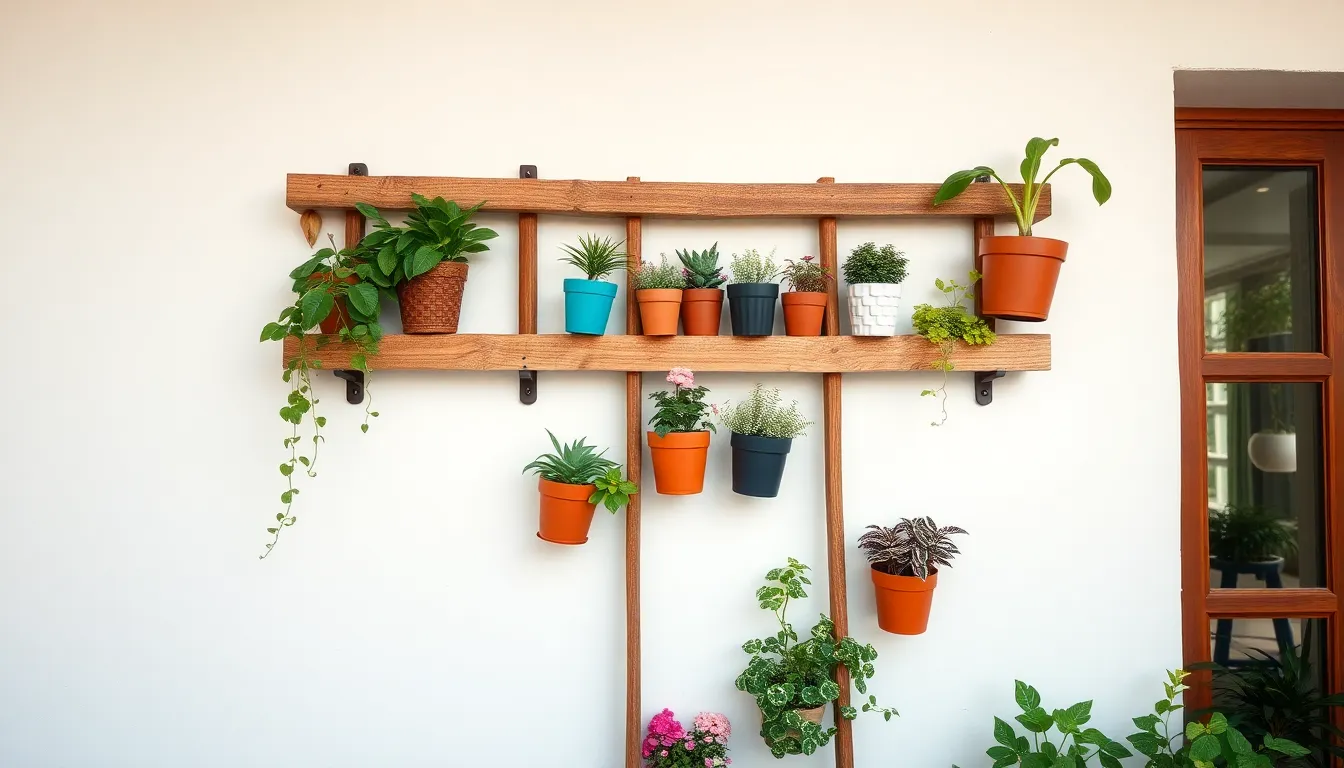
Safety becomes our top priority when installing any hanging ladder plant display. We must follow exact guidelines and techniques to ensure our vertical garden remains both beautiful and secure.
Wall Mounting Techniques
Robust wall anchors form the foundation of any successful wall-mounted ladder installation. We need to select anchors specifically designed for our wall material, whether we’re working with masonry, drywall with studs, or other surfaces.
Mounting height requires careful consideration to provide stable support for both the ladder and plant weight. We should position the mounting points so our ladder sits flush against the wall without any wobbling or movement.
Even weight distribution starts at the mounting stage by strategically placing attachment points along the ladder’s length. We can install hooks or holders directly on the rungs or sides to create designated spots for our plants.
Flush positioning prevents structural stress that could lead to failure over time. We must ensure our ladder maintains consistent contact with the wall surface across all mounting points.
Ceiling Installation Methods
Exposed ceiling beams provide the strongest mounting option for our hanging ladder displays. We should use heavy-duty hardware like S-hooks or ceiling anchors that are specifically rated for our expected load capacity.
Load capacity verification prevents catastrophic failure before we begin installation. We need to confirm our ceiling structure can handle the combined weight of the ladder, plants, and any additional decorative elements.
Personal fall arrest systems become mandatory when our ladder setup extends above 24 feet, following established safety best practices in the industry. We must prioritize this safety measure for any high installations.
Connection tightness requires double-checking to ensure every mounting point can bear the full weight load. We should test each connection point individually before adding any plants to our display.
Weight Distribution Guidelines
Even plant distribution across ladder rungs prevents dangerous unbalancing that could cause the entire display to fail. We must avoid concentrating too much weight on any single section or rung.
Maximum weight ratings shouldn’t be exceeded according to our ladder’s manufacturer specifications. We need to calculate the total weight of all plants, containers, and soil before installation.
Lightweight containers reduce overall load while maintaining the visual impact of our plant display. We can choose materials like resin or fiberglass instead of heavy ceramic pots to minimize stress on mounting points.
Ever-changing stress considerations include the forces created when we add or remove plants during maintenance. We should ensure our mounting system can handle these changing loads without compromising structural integrity.
Style Your Hanging Ladder With Plants Like a Pro
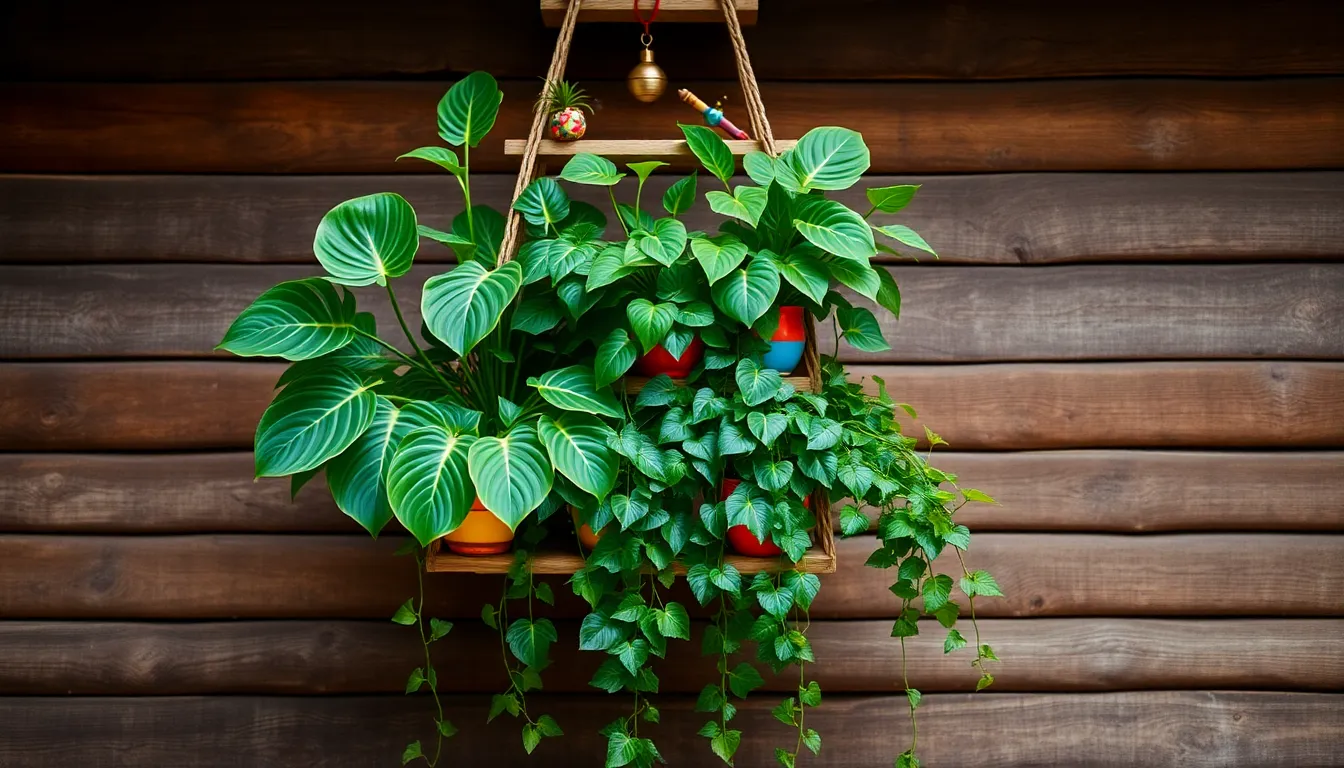
Transforming your hanging ladder into a stunning vertical garden requires strategic planning and artistic vision. We’ll guide you through professional styling techniques that create visual harmony and maximize your display’s impact.
Creating Visual Balance and Flow
Arranging plants for optimal visual balance means distributing weight and size thoughtfully across your ladder’s structure. Position larger plants like monstera or fiddle leaf figs toward the center or bottom rungs to establish stability, then surround them with smaller specimens such as pothos or philodendrons to create natural flow.
Distribute your plant collection evenly using the ladder’s horizontal rungs as natural guideposts. Each level should contribute to the overall composition without overwhelming adjacent sections. Leave strategic empty spaces between plants to prevent visual clutter and allow each specimen to showcase its unique characteristics.
Balance doesn’t mean symmetry in plant placement. Offset heavier plants with multiple smaller ones on the opposite side to achieve equilibrium that feels natural rather than forced.
Mixing Plant Sizes and Textures
Combine various plant types to add dimension and visual interest throughout your hanging ladder display. Large leafy plants like rubber trees provide dramatic focal points, while small succulents such as jade plants or echeveria offer delicate detail work. Trailing vines including string of hearts or ivy create cascading effects that soften the ladder’s rigid lines.
Incorporate contrasting leaf textures to enhance your display’s tactile appeal. Pair smooth, waxy leaves from snake plants with delicate, feathery foliage from ferns or asparagus plants. This textural variety creates depth and prevents your arrangement from appearing monotonous.
Vary your container sizes and shapes to complement the plant diversity. Hang some pots directly on the ladder’s rungs using S hooks, while placing others on steps or mounted shelves to create multiple display levels.
Adding Decorative Elements
Complement your plant selection with decorative accessories that enhance the overall aesthetic without overwhelming the natural beauty. String fairy lights throughout the ladder structure to create ambient lighting that highlights your plants during evening hours. Small ornaments like ceramic figurines or decorative stones add personality while maintaining focus on the greenery.
Paint or stain your ladder to match your room’s design scheme perfectly. White enamel finishes create modern, clean aesthetics that work well in contemporary spaces, while natural wood stains enhance rustic or farmhouse decor themes.
Choose unique planters that serve as artistic elements themselves. Handmade ceramic pots, colorful glazed containers, or woven macrame hangers transform functional plant holders into decorative focal points that reflect your personal style.
Maintain Your Hanging Ladder Plant Display
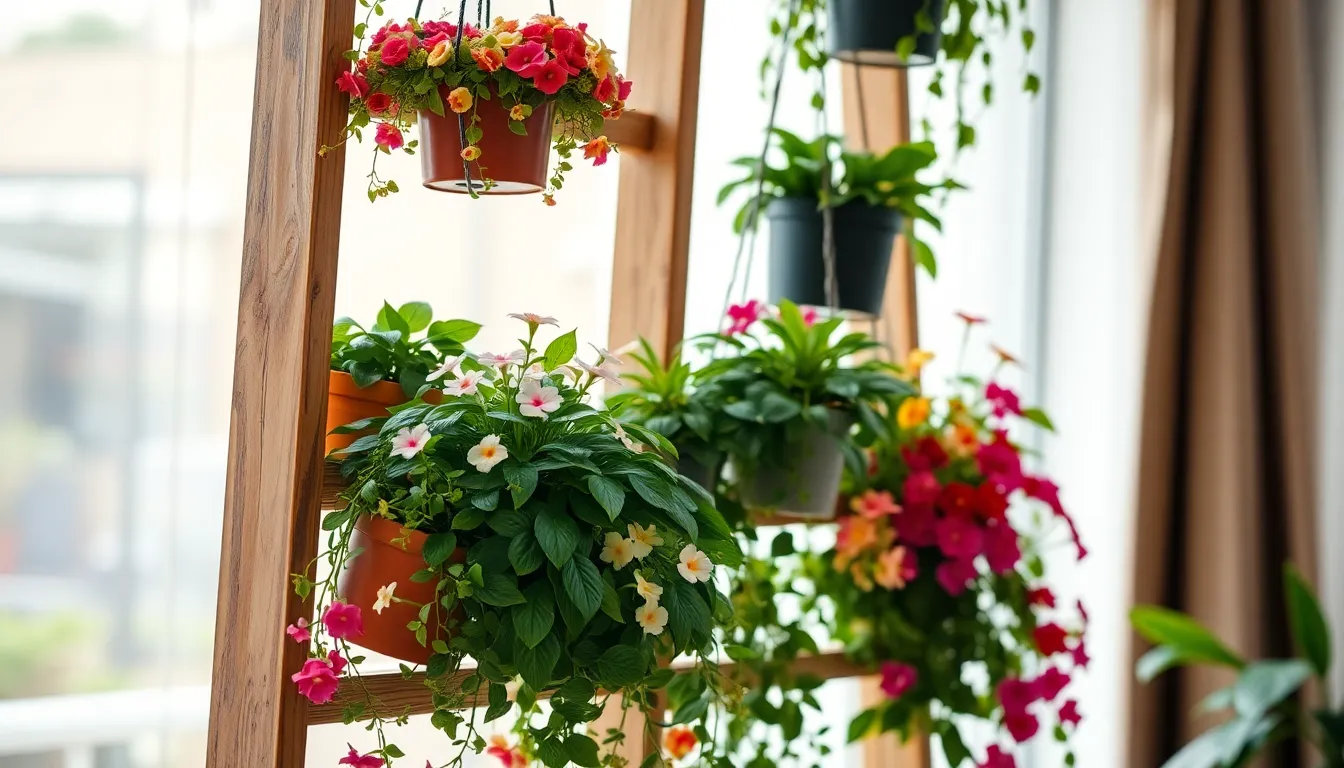
Proper maintenance ensures your hanging ladder plant display remains a stunning focal point while keeping all plants healthy and thriving. We’ll guide you through essential care strategies that address the unique challenges of multi-level plant arrangements.
Watering Strategies for Multiple Levels
Position drainage systems carefully to prevent water from pooling in lower tiers and causing root rot in your plants. We recommend using pots with drainage holes on every level and placing saucers or liners underneath to catch excess runoff.
Water each plant according to its individual needs rather than following a blanket schedule for the entire display. Different species and pot sizes require varying moisture levels, so we check soil moisture regularly by inserting our finger about an inch deep into the soil.
Start watering from the bottom level and work your way up to avoid oversaturating plants on lower rungs. This technique prevents water from dripping onto plants below and ensures each tier receives appropriate moisture without interference from upper levels.
Monitor moisture levels twice weekly to establish consistent care patterns while avoiding the common mistake of overwatering. We’ve found that checking individual plant needs prevents the root rot issues that frequently occur in tiered setups like ladder displays.
Pruning and Plant Care Tips
Remove dead or yellowing leaves immediately to maintain the neat appearance of your display and prevent disease from spreading to healthy plants. We trim these damaged sections using clean, sharp scissors to make precise cuts that promote healing.
Trim overgrown stems regularly to maintain proper shape and prevent plants from crowding each other on the ladder rungs. This grooming technique encourages bushier growth and keeps trailing plants from overwhelming the overall display.
Rotate plants every few weeks to ensure even light exposure and promote symmetrical growth patterns across all levels. We turn each pot a quarter turn to prevent plants from leaning toward the light source and developing lopsided growth.
Inspect for pests and diseases weekly during your regular maintenance routine to catch problems early before they spread throughout the display. We look for common signs like webbing, discolored spots, or unusual leaf damage that might indicate pest infestations.
Feed plants every few weeks with a balanced, water-soluble fertilizer to provide essential nutrients for vibrant foliage and healthy growth. We dilute the fertilizer to half strength to prevent burning delicate roots in the confined pot environment.
Troubleshoot Common Hanging Ladder With Plants Issues
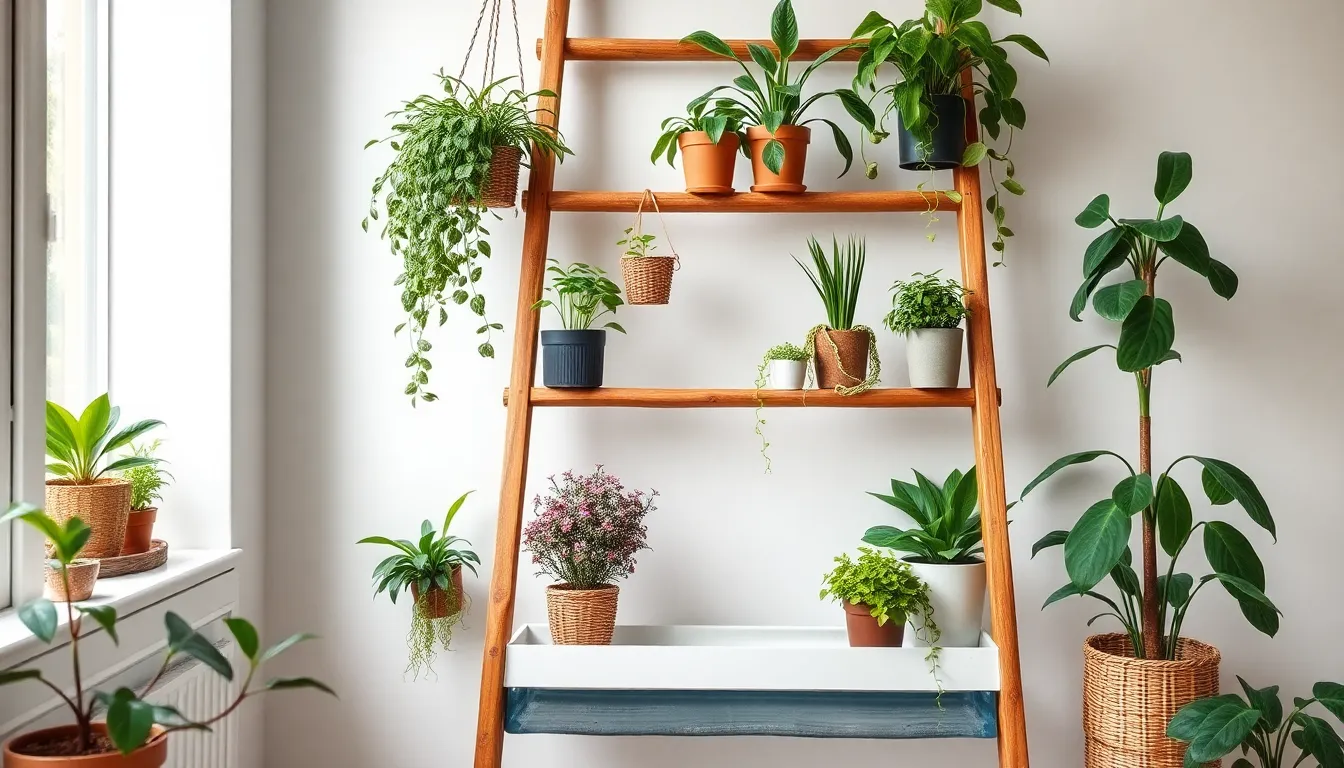
Even the most carefully planned hanging ladder displays can encounter challenges that affect plant health and your home’s safety. We’ll help you identify and resolve the most common problems before they become costly issues.
Preventing Water Damage
Overwatering creates the biggest threat to both your plants and your home. Root rot develops when soil stays wet too long, so we recommend checking moisture levels before each watering session. Allow the soil to dry somewhat between waterings rather than maintaining constant moisture.
Drainage holes in every pot prevent water accumulation at the bottom. Without proper drainage, excess water pools around roots and leads to plant failure. We suggest using pots with multiple drainage holes or drilling additional holes in decorative containers.
Protecting your floors and furniture requires strategic placement of water-catching systems. Place waterproof trays or mats underneath your hanging ladder to catch drips and overflow. Position the display away from electronics, wooden floors, or upholstered furniture that could suffer permanent damage from water exposure.
Humidity management prevents both plant stress and moisture problems in your home. Group plants together to create natural humidity pockets, or use humidity trays filled with pebbles and water. Light misting helps certain plants but should be done sparingly to avoid fungal growth on leaves and surrounding surfaces.
Managing Plant Growth
Uneven growth patterns develop when plants receive inconsistent light exposure. Rotate your hanging ladder plants weekly to ensure all sides receive equal sunlight. This practice promotes fuller, more symmetrical growth and prevents the leggy appearance that occurs when plants stretch toward their light source.
Fertilizer application requires careful timing and measurement to avoid root damage. Feed plants with balanced, water-soluble fertilizer every few weeks during spring and summer growing seasons. Reduce or completely stop fertilizing during fall and winter when plants enter dormant periods and can’t process nutrients effectively.
Regular pruning maintains both plant health and visual appeal. Remove yellow or dead leaves immediately to prevent disease spread and redirect energy to healthy growth. Trim back overly long stems to encourage bushier development and keep trailing plants at manageable lengths.
Lightweight pot selection reduces stress on your hanging system while simplifying maintenance. Choose plastic containers or woven baskets instead of heavy ceramic pots to minimize the load on mounting hardware. This approach also makes it easier to remove individual plants for thorough care or replacement when needed.
Budget-Friendly DIY Hanging Ladder With Plants Projects
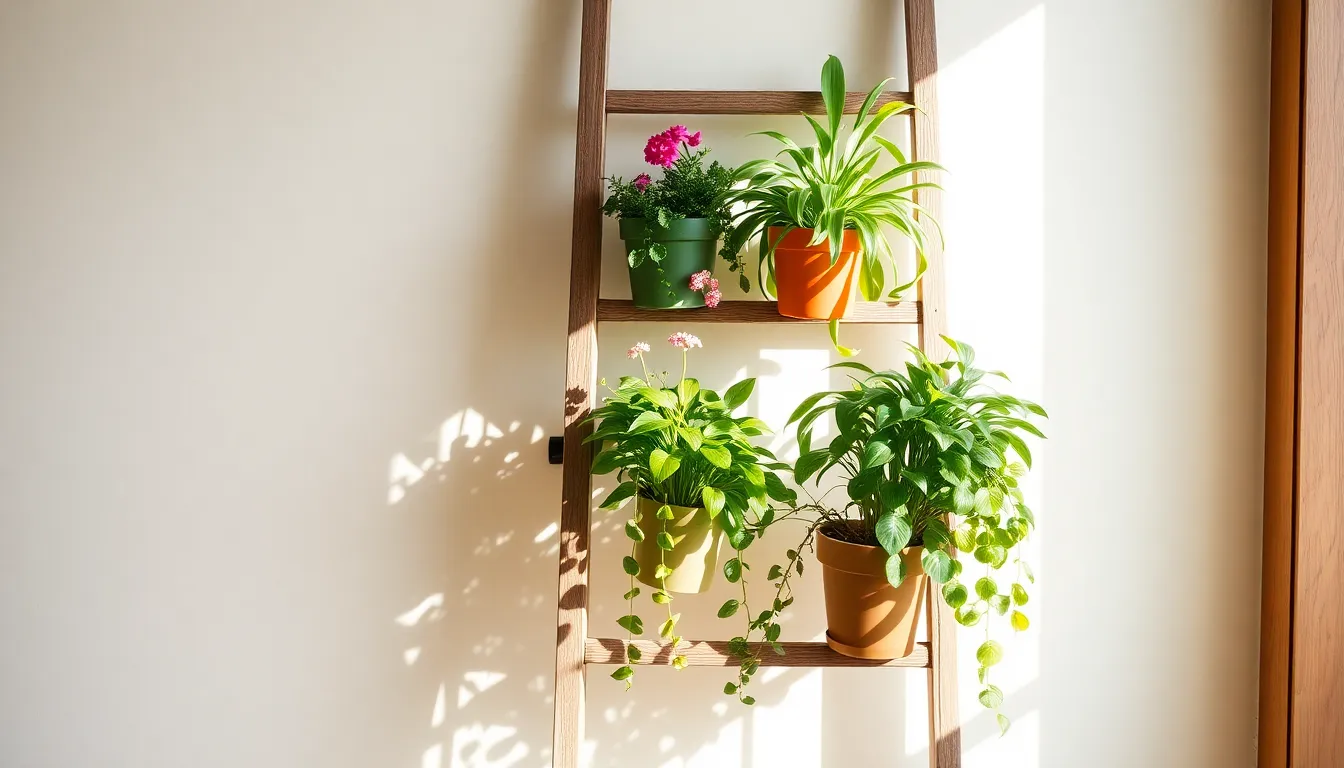
Simple Ladder Plant Hanger transforms any basic ladder into a stunning vertical garden without very costly. We can create this indoor display using affordable materials like wood or metal rods, then hang plants from the rungs with strings or place pots directly on the ladder steps. Suspending the entire structure from the ceiling using rope or chain creates that eye-catching hanging effect we’re after.
Vintage Ladder Floral Display offers an elegant approach using a rustic or antique ladder as our foundation. We’ll need to gather 30-50 greenery or floral stems from create stores, which provides excellent value when purchased in bulk. Matching stems in pairs ensures balanced hanging throughout our display. Tying stems to varied lengths of white thread or invisible nylon string creates ever-changing visual layers. Hanging the stems in staggered arrangements along the ladder rungs adds the texture and depth that makes this project so appealing.
DIY Wall Planter Ladder gives us a permanent solution that’s both sturdy and stylish. Cedar wood works perfectly for outdoor installations due to its natural weather resistance properties. We’ll cut two 40-inch vertical boards and several 17-inch horizontal boards to create our ladder frame. Attaching horizontal boards as rungs with wood glue and pocket hole screws ensures long-lasting stability. Flower pot clips hold small pots like 5-inch terra cotta containers securely in place. Staining or painting the finished wood provides weatherproofing while matching our existing decor.
Measuring and Installation Considerations prevent costly mistakes during our project. We need to measure spaces carefully, especially for indoor installations near windows or doors where clearance matters. Checking ceiling joists before suspending from above ensures secure anchoring that won’t fail over time.
| Budget-Friendly Materials | Cost Range | Best Use |
|---|---|---|
| Thrifted ladders | $10-25 | Vintage aesthetic projects |
| Cedar wood planks | $20-40 | Outdoor installations |
| Nylon fishing line | $3-8 | Lightweight hanging systems |
| Flower pot clips | $15-30 | Secure pot attachment |
| Bulk create stems | $25-50 | Large floral displays |
Money-Saving Strategies maximize our project’s impact while minimizing costs. Thrifted or repurposed ladders offer character at a fraction of new ladder prices. Buying greenery or flowers in bunches allows us to separate them into individual stems for better value. Simple supplies like nylon fishing line or white thread work just as well as expensive hanging hardware. Inexpensive wood varieties like cedar or pine paired with basic tools like a miter saw and Kreg Jig keep our construction costs reasonable.
Creative Layering Techniques add professional polish to our budget-friendly displays. We can hang plant stems or pots from ladder rungs using simple string or clips rather than costly mounting systems. Building ladder frames from basic wood creates opportunities for both fixed and hanging display styles. Layering plants creatively adds depth and texture that rivals expensive store-bought plant stands.
Versatile Style Options ensure our budget project fits any decor theme. Rustic vintage ladders complement farmhouse and bohemian styles perfectly. Modern minimalist designs work well with sleek metal or painted wood ladders. This flexibility allows us to create custom looks that enhance our indoor or outdoor spaces with greenery while staying within budget constraints.
Purchase Ready-Made Hanging Plant Ladders
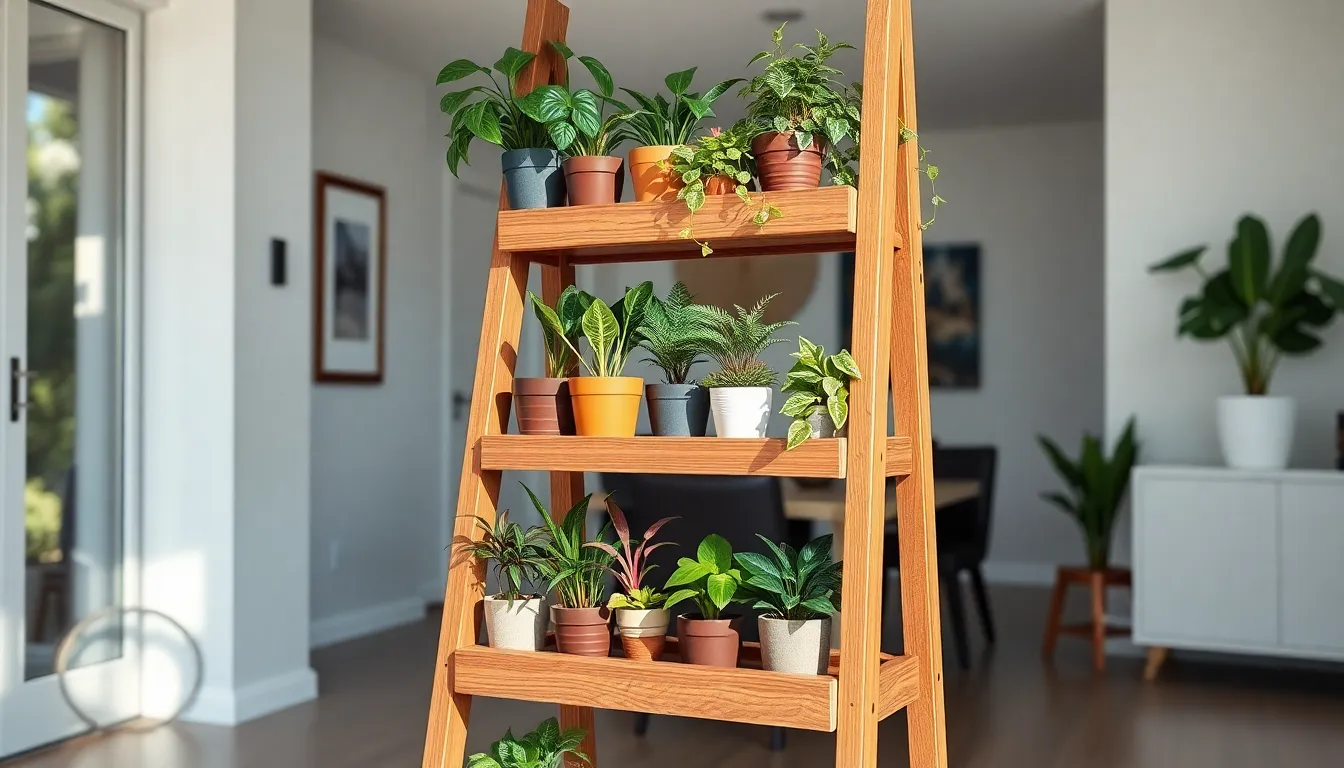
Ready-made hanging plant ladders offer convenience for those who prefer professionally crafted answers over DIY projects. Etsy stands out as a premier marketplace featuring handmade wooden tiered racks from skilled craftspeople who specialize in plant display furniture. These artisans create stunning pieces using premium materials like oak, ash, and walnut that provide exceptional durability and aesthetic appeal.
Popular Ready-Made Options Available:
| Ladder Type | Material Options | Key Features |
|---|---|---|
| Tiered Plant Racks | Oak, Ash, Walnut | Multiple display levels |
| Wall-Mounted Shelves | Reclaimed Wood | Space-saving design |
| Freestanding Ladders | Steam-Bent Wood | Portable placement |
| Multi-Level Stands | Various Hardwoods | Storage integration |
Freestanding ladder shelves provide flexibility since they don’t require wall mounting or ceiling installation. Wall-mounted versions maximize floor space while creating dramatic vertical displays that complement modern and rustic decor styles. Multi-level plant stands often incorporate additional storage compartments for gardening tools and supplies alongside plant display areas.
Steam-bent wooden ladders offer unique curved designs that add artistic flair to any space. Reclaimed wood options appeal to environmentally conscious buyers who appreciate sustainable materials with character and history. Premium hardwood selections ensure longevity while providing natural beauty that enhances rather than competes with your plant collection.
Essential Features to Consider:
Professional manufacturers often include complementary accessories like macrame hangers and jute ropes that support trailing plants effectively. Coir poles integrated into some designs provide climbing support for vines and other vertical growing plants. Many ready-made options feature pre-drilled holes and mounting hardware that simplify installation while ensuring structural integrity.
Quality craftsmanship means these ladders can handle substantial weight from multiple potted plants without sagging or structural compromise. Finished surfaces resist moisture damage better than untreated wood while maintaining the natural aesthetic that makes wooden plant displays so appealing. Professional construction ensures proper weight distribution across all rungs and mounting points.
Shopping Considerations:
Measure your intended space carefully before purchasing to ensure proper fit and proportion. Consider the weight capacity specifications provided by manufacturers to avoid overloading your selected ladder. Review customer photos and testimonials to gauge real-industry appearance and durability over time.
Shipping costs for wooden furniture can be substantial due to size and weight considerations. Compare total costs including delivery when evaluating different options from various sellers. Custom sizing options may be available from some craftspeople for unique spaces or exact design requirements.
Ready-made answers eliminate the guesswork involved in DIY construction while providing professional finishing that enhances your home’s aesthetic appeal immediately upon installation.
Conclusion
Hanging ladder plant displays offer the perfect solution for anyone looking to maximize their growing space while creating stunning visual impact. We’ve shown you how these versatile installations can transform any room or outdoor area into a thriving vertical garden.
Whether you choose to build your own DIY version or invest in a ready-made option the key is selecting the right plants materials and location for your exact needs. Remember that proper installation and regular maintenance will ensure your hanging ladder garden remains both beautiful and safe.
With the techniques and tips we’ve shared you’re now equipped to create your own eye-catching plant display that’ll serve as both a functional garden and an artistic focal point. Your vertical gardening journey starts with just one ladder and a few carefully chosen plants.
Frequently Asked Questions
What is a hanging ladder plant display?
A hanging ladder plant display transforms a simple wooden or metal ladder into a stunning vertical garden by suspending it from the ceiling or mounting it against a wall. This innovative approach allows you to showcase multiple plants at different heights, creating a beautiful tiered garden effect that maximizes your growing space while adding visual interest to any room.
What are the benefits of using a hanging ladder for plants?
Hanging ladder displays offer multiple advantages: they maximize vertical space in small homes, create striking visual impact with geometric interest, allow easy plant maintenance and access, cost significantly less than specialized plant furniture, and provide creative flexibility for experimenting with different plant combinations and arrangements to match your evolving gardening skills.
What materials work best for hanging plant ladders?
Wooden ladders offer rustic charm and sturdiness, perfect for traditional decor. Metal ladders provide sleek, modern aesthetics with superior strength for heavier plants. Bamboo ladders are an eco-friendly lightweight option that combines sustainability with style. Choose based on your decor style, weight requirements, and environmental preferences for optimal results.
Which plants work best for hanging ladder displays?
Low-maintenance succulents and air plants thrive in well-lit areas with minimal care, perfect for busy lifestyles. Trailing vines like Pothos and String of Pearls create dramatic cascading effects. Herbs transform your ladder into a functional kitchen garden, providing fresh ingredients and delightful fragrances while adding practical value to your display.
Where should I place my hanging ladder plant display?
For indoor placement, choose bright corners or entryways with indirect sunlight, ensuring secure installation for safety. Coordinate with existing decor for seamless integration. For outdoor installations, use weather-resistant materials, ensure proper drainage systems, and position where plants receive appropriate light while maximizing your small outdoor space effectively.
How do I safely install a hanging ladder display?
Use robust wall anchors and distribute weight evenly for wall mounting to prevent wobbling. For ceiling installation, verify load capacity and use heavy-duty hardware rated for the total weight. Distribute plants evenly across rungs to avoid unbalancing, and choose lightweight containers to reduce overall load and stress on mounting points.
How do I style my hanging ladder plant display?
Create visual balance by positioning larger plants at center or bottom rungs for stability, surrounded by smaller specimens. Mix plant sizes and textures for dimension, vary container shapes for visual interest, and incorporate decorative elements like fairy lights. Arrange thoughtfully to enhance natural flow while maintaining the plants as the focal point.
How do I maintain my hanging ladder plant display?
Water according to individual plant needs, ensuring proper drainage to prevent overwatering. Prune regularly by removing dead leaves and rotating plants for even light exposure. Conduct regular inspections for pests and diseases, feed with balanced fertilizer as needed, and monitor moisture levels to keep your vertical garden healthy and visually appealing.
What are common problems with hanging ladder displays?
Common issues include overwatering leading to water damage and uneven growth patterns from poor light distribution. Prevent problems by using pots with drainage holes, waterproof trays to protect surfaces, managing humidity levels, ensuring adequate light exposure, and selecting lightweight containers to ease maintenance and reduce structural stress on the display.
Can I create a hanging ladder display on a budget?
Yes! Transform basic ladders with affordable materials, use vintage ladders for unique charm, or build wall planter ladders with budget-friendly supplies. Shop thrift stores for containers, buy plants in bulk, layer creatively for maximum impact, and choose versatile styles that complement various decor themes while keeping costs minimal.
Should I buy a ready-made hanging plant ladder?
Ready-made options include tiered plant racks, wall-mounted shelves, freestanding ladders, and multi-level stands with professional craftsmanship and quality materials. Consider this option if you prefer convenience over DIY projects. Measure your space carefully, understand weight capacity requirements, and compare features to find the best professionally crafted solution for your needs.

